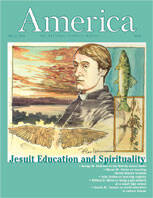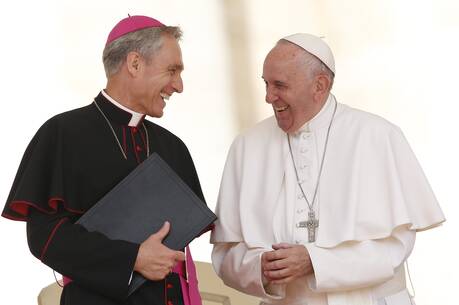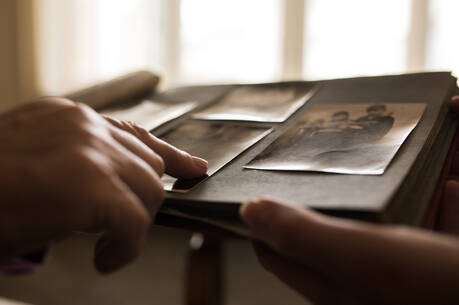Hopkins seems to think the whole universe is wonderful. I have a friend who just told me yesterday he has brain cancer. What does Hopkins have to say to him? A student at Loyola University Chicago asked this question recently in a class on Victorian literature, during a discussion of the English Jesuit Gerard Manley Hopkins’s poem God’s Grandeur. She was challenging the vision of the universe as beneficent and beautiful that the poem presents. The short answer to her question, of course, was: When we get to the dark sonnets, you will see that Hopkins also knew sorrow and despair. The full answer, however, is that there is far more to Hopkins than joy and sorrow. There is a powerful spiritual wisdom in his poetry, and that wisdom is grounded in the Catholic beliefs that Hopkins expresses so passionately in his poems. That raises a further question: is it appropriate to teach this wisdom and those beliefs in a literature class? On the other hand, how could one deny this student and her friend the consolation and wisdom that would be provided by a deeper understanding of Hopkins’s vision of the transcendent?
To add a further complication (and interest) to the student’s question, the person teaching God’s Grandeur that day was a guest lecturer who is also an administrator, Dr. Joseph Sandman, the university’s vice president for advancement. Thus, a man who spends much of his professional time asking donors to contribute to the university was now being challenged to tell a student why she should invest the time and effort to master not only Hopkins’s difficult language, but the concepts that constituted the poet’s faith. The situation challenged us to ask, what is this Jesuit Catholic university offering that student and her troubled friend that they would not get in a public university? After all, our university charges a substantial tuition that many families must sacrifice to pay, and it receives many generous contributions from donors. This question is, therefore, one that faculty and administrators alike need to think through, for, as that brief team-teaching experience illustrated, we are indeed all in this together.
Of course, Hopkins is taught in many kinds of colleges and universities, Catholic or not. Teaching Hopkins is first and foremost an act of teaching important works of literature. But a Catholic university is supposed to offer something more. That something more is deeply rooted in the European university tradition, which was, after all, a Catholic tradition for several centuries. It is also something of an anomaly in what John Maynard, in his Victorian Discourses on Sexuality and Religion (1993), calls our pro-sex, religion-wary century, in which the only scandal that remains in the postmodern world is that of religious seriousness. Why teaching these Catholic beliefs should be any more awkward than, say, exploring the Victorian sexual underworld hinted at in Thackeray’s Vanity Fair is a question that bears investigation.
A university’s Catholic identity provides something that is value-added to the other elements by which we measure a good education: intellectual comprehensiveness and challenge, academic freedom and respect for the multiplicity of cultural and faith traditions that characterize contemporary life. A university’s Catholic identity provides an opportunity to counter the negative images of Catholicism that run so strongly in our American culture and to show that Catholicism is far more than the authoritarian, anti-intellectual, anti-sex throwback to the dark ages that it is sometimes made out to be. In a Catholic university, the things of the spirit are treated as real and important. One of the values that it adds is to remind us that the Catholic intellectual tradition is a foundational element of our culture and that this includes contributions to scientific thought.
These issues were raised most clearly at Loyola University Chicago some eight years ago, when John J. Piderit, S.J., who had just been installed as the school’s president, stated that one of Loyola’s goals would be to make the university’s Catholic identity, in the Jesuit style, a defining and distinguishing feature. Every department was asked to specify how it would contribute to this identity. This struck many as an addition to their roles as faculty members and raised a question: Is supporting the Jesuit Catholic mission a part of an academic department’s responsibility? And if so, how?
That question came up again this past year when the English department rewrote its mission statement. The most difficult issue was whether or not to include a sentence supporting the Jesuit Catholic mission. We finally settled on simply agreeing to support the University’s mission, without mentioning Jesuit and Catholic. We also used language in our quite eloquent mission statement to indicate that we do all agree to support such values as freedom of inquiry, the pursuit of truth and care for others through teaching, service and scholarship. More recently, the university’s faculty council confronted the same question when it began drafting a document for the formation of a faculty senate. That particular question has not yet been settled, but the discussion of it has been a great boon, for these issues are crucial to our self-understanding and functioning. The discussions have shown some of us that our work is more than a career; it is a vocation.
My own role in the English department’s response to Father Piderit’s request was, with some friendly prompting from the department’s chairperson, Suzanne Gossett, to teach a course that was still listed but had long been neglected: on the Bible as literature. It was the most challenging course I have ever taught, and what I learned from it can never be fully measured. The Bible can be studied with benefit in departments of art, history and even science, as we continually struggle with questions of the origins, nature and ends of the universe, with the history of scientific and religious thought regarding that universe and with the realizations of that thought in the arts. Such a course could, therefore, serve as a cornerstone for a core curriculum, but that is a subject for another day.
I agreed to teach that course because I recalled how edifying the Bible had been for me when I was a Loyola Chicago student in the mid-1960’s. In most Catholic universities, including Loyola, Catholic identity did not at that time seem to be an issue, although I know now that those years were actually a period of great change in Catholic higher education. In those days the student body was by and large Catholic, drawn from Chicago’s Polish, Italian and Irish neighborhoods. The faculty included substantial numbers of Jesuits, and the lay faculty also tended to be Catholic. The courses required of all students included Old Testament, New Testament, Christian marriage, the papal encyclicals, logic and public speaking. There was a coherence to this program, and we spent many hours discussing the texts that all of us were reading.
The greatest benefit to me was to discover that Catholicism includes much more than what I had been taught in grade schooland sometimes rebelled against. I still have my freshman-year copy of William Foxwell Albright’s From the Stone Age to Christianity, a book by a great U.S. biblical scholar that demonstrates the unbroken continuity of religious expression throughout human history. Even more significant was the revelation that the Bible need not be read with an exaggerated literalism, but should be understood as an inspired document that works through the horizon of historical and cultural meanings available in ancient times, and thus requires interpretation. For the first time, I heard the word hermeneutics, and I found that Catholicism is an intellectual enterprise of great magnitude and importance.
The downside of our undergraduate experience was that we were rather parochial. Multiculturalism consisted of Irish meeting Poles and Italians and suburbanites meeting city dwellers. I can recall only one student of color, and there were only two women in the English department. That Hinduism or Islam could also be studied did not occur to us students, and, as far as I know, these religions were not part of the curriculum, although I know now that at the time the Jesuits were engaged, for example, in the sort of extensive study of Indian languages and cultures that resulted in a book on the Bhagavad Gita by James Reddington, S.J.
Since those days, Loyola Chicago, like many other institutions, has moved to recruit a more diverse, national and international student body, to professionalize its faculty and to take its place among the country’s large doctoral institutions. This means, in part, that hiring is governed by discipline-based criteria. This also means that research and publication receive more recognition and support than in the past and that Catholicism is presented to job candidates (truthfully and rightly so) as something that will not interfere with their research agendas or their teaching.
Some faculty members have been attracted by Loyola’s Catholic identity, but others came with the understanding that Loyola is a university like any other, except, perhaps, for the work performed by University Ministry, and that its Catholicity would not make any difference in their lives. Other teachers, however, both Catholics and non-Catholics, have been attracted to Loyola because they associate Jesuit Catholic universities with intellectual excellence. Some perhaps came because the job market offered few choices; but, taken all together, Loyola has grown to be more reflective of the profession as a whole. Unlike narrowly sectarian colleges, Jesuit Catholic universities choose to be open to the world and its ideasa stance consistent with the Jesuit principle of intellectual thoroughness.
Now, however, some aspects of academia appear to be in conflict with the Catholic identity of an intellectually open Jesuit university. Faculty attitudes toward Catholicism vary. Some see it as a kind of quaint mythology; others are ideologically opposed. Some think Catholicism is linked to racism, sexism and homophobia, and they therefore decline to support the concept of Catholic identity. Some Catholic members of the faculty are working for change from within the church, while others are more concerned with the loss of a shared understanding of what Catholicism means. No doubt, Catholic teachers need to be aware that there is some anti-religious feeling among their colleagues. On the whole, however, most faculty are respectful of the religious element, and some have recovered their own faith by coming to a Catholic university. However, even the most devout Catholics tend to assume that it is not the business of faculty to promote the university’s Catholic identity, and so for all the question remains: what is the role of the faculty with respect to the university’s religious mission?
Most faculty members hesitate to bring up their religious beliefs in the classroom. There are valid reasons for this hesitation. Catholics are not generally proselytizers. Many of us have been trained in public and private universities in which the civic respect for religious differences built into our laws, combined with a tactful delicacy based on respect for spiritual privacy, meant that no one discussed religion during our entire graduate education. And so we have erred in the other direction. Not only do we not discuss the religious ideas underlying the topics we teach and write about; in some cases, we do not even see them. This impoverishes us as scholars, and it impoverishes our students.
As Joseph Sandman and I taught Hopkins this past semester, we made clear that we were not missionaries preaching to pagans. Rather, the Catholic tradition constitutes a portion of the content of Hopkins’s works, and it is as valid to discuss the influence of Jesuit spirituality and Duns Scotus on Hopkins as it is to discuss the influence of female emancipation and Caroline Norton on Thackeray. And just as some students are personally influenced by Thackeray’s feminism, so are some moved by Hopkins’s spirituality. But in neither case have we, the teachers, necessarily proselytized. Our role is not to become personally involved with students’ lives, but rather to give them the intellectual tools with which they can improve their lives, for, as Juan Ortega y Gassett once said, By means of ideas we see the world.
Students responded to Hopkins in various ways, when they were asked to write a brief paper on this poet. One student described himself as a nonbeliever and then went on to give a brilliant exposition of Hopkins’s ideasand why should he not? For the final paper, I permitted students to choose their topics. A surprising number chose to write on Hopkins. Three of these happened to be seminarians who discussed Hopkins’s ideas skillfully and were pleased to have the opportunity to do so.
One young woman noted poignantly that both her parents had been married and divorced three times and that neither had ever introduced her to any religious ideas or practices. For her, therefore, the two most meaningful writers in the course had been Elizabeth Barrett Browning and Gerard Manley Hopkins: Browning for her profound and moving expression of love for her husband, and Hopkins for his expressions of faith and spirituality. These writers, she wrote, gave her hope and direction for her own future.
Hopkins’s great poem The Wreck of the Deutschland presents individual persons caught in a great public and historic tragedy, as well as in a time of private terror. It makes the students aware of surprisingly recent religious oppression against Catholics (a new idea to many). It also evokes a deep respect for a courageous woman, a nun drowned in a shipwreck, a lioness...breasting the babble. Learning about Hopkins’s life also helped the students to understand the power of a passionate vocation, the difficulty of harnessing one’s very soul to the work one has been called upon to perform. And finally, Hopkins does have something to offer to my student and her friend with cancer. That something is the insight, the revelation, with which he endows the tall nun on the Deutschland: Ah! there was a heart right!/ There was a single eye!/ Read the unshapeable shock night/ and knew the who and the why. The who and the why is of course a view/ of the gospel proffer, a pressure, a principle, Christ’s gift. The poem is essentially about finding meaning in suffering, warmth in winter, love in lightning. It offers the stricken student much.
If students wish to take these ideas into their hearts, as well as study them in a college class, all is well. It must, of course, be their choice, and I am as willing to explain T. H. Huxley’s scientific materialism, which has more meaning for some students, as I am to explain Hopkins’s faith. Both are a part of my responsibility as a teacher. It is not just Hopkins who serves as a vehicle for the value-added element of a Catholic university, and not just Catholic ideas that we teach. For the novels of the Brontës are filled with religious beliefsprimarily derived from their Anglican faithand R. K. Narayan’s novels resonate with the spiritual insights of Ghandi. These too need to be understood.
In a Catholic university we are not less free, but more free. We teach in a setting in which religion is valued and move in surroundings that are permeated with visible and audible expressions of respect for and heartfelt reliance on faith. We are supported in our intellectual enterprise by a university ministry, by Hillel and by the Islamic mosque on campus. The late and much esteemed Robert Schneider, one of my mentors at the University of Illinois, Urbana, summed it up quite simply. He said, in response to a student who was deriding the religious assumptions of a writer we were studying, that anyone who does not understand the importance of religion in human history is not well educated.
Martin Svaglic of Loyola Chicago wrote some 50 years ago that the best thing that a Catholic university can do for Catholicism is to be a great university. Intellectual integrity and distinction require that we include the religious element of human life in our teaching and scholarship. In a Catholic university, we are not only more free to do so, we owe it to our students to ensure that they are cognizant of the place of religion and understand its concepts. This is not proselytizing. It is good scholarshipand true education.








